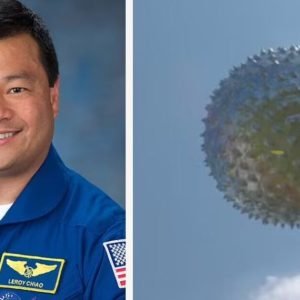
In the small village of Ogba-Ojibo in central Nigeria, sitting at the confluence of two of the nation’s largest rivers – the Niger and Benue – 27-year-old Ako Prince Omali is counting the steps carved out of the dirt, which lead down the loam-coloured banks of the river Niger. This river bank, dotted with tufts of spiky grass, is where villagers come to fish or wash produce and laundry.
Just last week, three of the steps were submerged during one night of rain, which raised the water level by about five metres. Normally, you can count seven steps down into the river. Now, only four remain above the surface of the water, the sticks bracing the muddy steps having washed away in the deluge.
Omali, a subsistence farmer whose one hectare of cropland has been wholly submerged, has been monitoring the level of water in the river for the past few weeks. The third-longest on the continent, the Niger is a major river in West Africa, originating in the Guinea highlands and discharging into the Atlantic Ocean via the expansive Niger Delta.
Flooding, one of the most common natural disasters in the world, is a seasonal occurrence for the 4.5 million people living in Kogi State, named for a Hausa word meaning river. Most Ogba-Ojibo villagers are subsistence fishermen and farmers whose livelihoods are especially susceptible to environmental changes.
Nigeria has the second-highest number of people in the world vulnerable to flooding after India – 15 million in total. In 2022, 470,000 people in Kogi alone were affected by flooding.
But this year is expected to be particularly hard. As of mid-September, one million people have been displaced following the collapse of a dam in Borno State, with some still stranded in their homes, others fleeing to relatives in other states or government-supported displacement camps. In Kogi, a further 250,000 people are at risk of displacement, according to local authorities.
Usually, aid agencies such as the Red Cross, the International Organization for Migration, or the State Emergency Management Agency step in at this point to distribute emergency food supplies, but while this is welcome, it does not address the underlying issue – that the floods come every year.
Now, new innovative programmes are starting to appear, aiming to help people prepare for floods in advance.
Three months of disruption every year
New ideas are what is needed here, says Omali, as the floods have been getting worse for years across the country as a whole. Back in 2012, when Omali was 15, he recalls, was when “the flooding became very disastrous” for the residents of his home in Kogi State.
The mud-patched bamboo hut that his wife and young daughter live in with him has been completely flooded this year, along with the small plot where his parents toiled over rice and yams when he was young.
During his childhood, he says, “We started relocating when the floods came, which would be for two and a half to three months [each autumn] every year”. The family would cross the river in small paddle boats with their few belongings to Idah, located a few kilometres away on higher ground. It is where Omali goes with his own wife and child when the water gets too high.
Life in Idah is far from easy when the family makes its home there for those few months each year. They squat under bamboo sticks covered with cellophane bags to create a makeshift shack; the children’s schooling comes to a halt as all the schools are closed.
“People are crammed together, there are challenges with ventilation, we have very little food,” says Omali. “The [lack of] access to hygiene, [clean] water and facilities is very stressful.”
During these difficult periods, all 300 households of Ogba-Ojibo lose access to their farmland.
It can take up to four months for the floodwaters to subside, draining away fertile, delicate topsoil in the process.

These days, Omali farms just under one hectare (2.4 acres) of rice and yams on land inherited from his late parents along with his wife, Blessing, to feed themselves and their four-year-old daughter. They sell what they have left over at the local market.
2021 was one of the best harvest years because the floods were lower than usual – Omali and Blessing managed to make 300,000 naira ($183) during the year. The following year, he made only 100,000 naira ($61). And last year, they made nothing at all.
When times are especially lean, Omali takes out loans or works as a casual labourer within the village to make ends meet.
But this past June, Omali says he discovered something to give him a bit of hope. He attended a baraza (community meeting) conducted in Ogba-Ojibo by GiveDirectly, a United States nonprofit providing humanitarian aid in the form of cash payments or bank transfers.
There, he learned about a new programme with a difference from the usual food aid programmes. Under this new scheme, those residing in flood-prone areas are given the opportunity to receive money before the floods hit, to help communities brace for the aftershock by stocking up on household goods or whatever else they choose to buy, rather than just receiving food and other essentials afterwards. Some 30,000 people enrolled over two weeks, says Natasha Buchholz, GiveDirectly’s senior manager based in Mozambique.
The different approach offered by the programme involves artificial intelligence (AI), which the organisation hopes will make more of a difference to people in flood-vulnerable communities like Ogba-Ojibo.

Using AI to fend off disaster
A few years ago, Alex Diaz, the head of Artificial Intelligence for Social Good on Google.org’s philanthropic team since 2019, started brainstorming ideas with his team, members of Google Research, and humanitarian nongovernmental organisations on how to better understand global climate-induced problems to develop the best solutions.
The answers do not “always have to be technical”, he tells Al Jazeera over a telephone call from New York City. The goal is to support nonprofits such as GiveDirectly to build or leverage AI tools, such as the SKAI disaster damage detection model that Google Research built in conjunction with the World Food Programme and is now scaling globally, in more than 80 countries, across 1,800 sites.
This model can also be used to pinpoint the areas that are most likely to be hit the worst by flooding.
A major predicament when it comes to disaster aftermath, whether it is a massive earthquake or devastating flooding, is that aid workers “don’t know where to go”, says Diaz.
In 2022, after the devastation wreaked by Hurricane Ian in Florida and Puerto Rico, Google used satellite imagery overlaid with socioeconomic data to identify those most in need of help as the Federal Emergency Management Agency (FEMA) can take weeks or even months to gather this data, according to Diaz.
“Post-disaster, time is of the essence. We’re using digital layers to get money out the door, as fast as possible.”
In remote places in Nigeria, going door-to-door out in the field is extremely time-consuming and bandwidth is always stretched. So, since 2020, Google’s research team has been building AI disaster detection models, which can be used to identify individual buildings that have been destroyed by hurricanes, floods and other natural disasters.
The detection system uses an amalgamation of Google satellite imagery and other available data, including publicly available weather products, gauge data from rivers and satellite imagery as well as information the Nigerian government provides, to “train” a global model to understand highly specific locations.
In Nigeria, Google’s AI for Social Good team has also been focusing on anticipatory actions to mitigate flooding risks from the Niger River in Kogi State. The idea was that “deep-learning” machine systems could be designed to forecast natural disasters, “with better granularity [more accuracy] and more lead time than what we currently have as the status quo”, explains Diaz.

Flooding ‘will intensify’
Dan Quinn, GiveDirectly’s director of humanitarian programmes, says that flooding in Nigeria is only set to get worse.
“We expect to see increasingly intense flooding in coming years due to climate change, which is increasingly difficult to predict as rains come earlier or later than we might expect.” He continues: “Major flood events also change the physical flow of rivers, which can put certain areas at an increased risk of flooding in subsequent years after a single major event.”
“Early warnings without early actions is a missed opportunity,” says Diaz. According to the United Nations Office for Disaster Risk Reduction, every $1 invested in risk reduction and prevention can save up to $15 in post-disaster recovery, while every $1 invested in disaster-resilient infrastructure saves $4 in reconstruction.
Besides cash aid, other climate resilience strategies include bolstering early warning systems, community education and training in disaster preparedness, investing in flood-resistant infrastructure, and climate-resilient agriculture. Conservation of wetlands and reforestation can also strengthen natural flood defences.
The US Chamber of Commerce has found that billion-dollar disasters are now the norm with the spike in weather-related catastrophes. In 2022, natural disasters cost more than $360bn worldwide.
“I want my son to live in a world with climate change where it’s not just reactive responses,” says Diaz.
Around 2023, GiveDirectly decided to start investing more in preemptive activities, says Buchholz, the senior manager. The idea is to provide a lifeline before disaster strikes via anticipatory payments, using AI programmes to help predict which communities are the most exposed. “We’re learning a lot, it’s a very dynamic situation,” she says.

The flooding in Kogi is anticipated to flare up badly over the next few weeks.
GiveDirectly’s project in Kogi begins with geo-targeting the most at-risk areas. Once the project areas are established, there is a registration process during which potential recipients respond to a short survey via SMS to determine their eligibility for support, followed by a few careful verification processes to confirm identities. The scheme uses USSD shortcodes, which operate via a SIM-based system, allowing people to access services on old-style mobile phones as well as smartphones.
GiveDirectly’s call centre is based in Ilorin State, about 350km (217 miles) west of Kogi, and if they can’t reach individuals to confirm their identities by phone, they will try to do so in person via the field team instead.
As of this week, GiveDirectly had already paid 53 individuals across three different wards, but a total of 52 communities with 4,500 recipients over six wards in Kogi State are expected to be paid this flood season.
Besides working with local leaders such as village elders to verify appropriate field locations, GiveDirectly also partners with banking institutions to make sure recipients have access to new verification methods, like ID cards, as recipients often live in remote and underserved areas.
When the flood season begins, GiveDirectly uses forecast data from Google to identify flood-prone areas. “Triggers” are activated if the area of concern is covered by water rising above or crossing a predetermined threshold, Buchholz explains. GiveDirectly is alerted via an email notification, and anticipatory cash for approved recipients is then released into their bank accounts for them to spend freely. For now, the programme mostly pays money this way, but for those who do not have access to a bank account, the team will explore other options such as mobile money wallets. Most recipients stock up on food and household necessities, while local markets are still open.
Those residing in communities with flood triggers will receive a first payment before the brunt of the floods actually arrives, of 177,866 naira ($105). After two weeks, the flood situation is reassessed: If it is bad, two more consecutive payments, a month apart, will be paid out to recipients.
“This is the first time we’re using AI models in Nigeria to forecast floods and make payments based on that,” says Federico Barreras, GiveDirectly’s humanitarian programme manager.

‘If we relocate, we won’t have any land’
Omali received his first transfer of 177,866 naira on August 31 this year. “I was very, very happy – at first I couldn’t contain my joy,” he says. “I shared the money with my wife, and she went to buy foodstuffs: maize, rice, beans, condiments for making soup.”
From his first payment, Omali has also set aside 90,000 naira (just under $55) for repairs to their home after the flooding subsides. For now, they’re still staying in Ogba-Ojibo, although the rains have already begun to damage their hut.
Ibu Arome, 65, the village chief, is a farmer like his constituents. When this programme first came to the village, he had no phone and was therefore unable to apply. Regardless, he is thankful for their support, he says. “Everyone has a fair opportunity to apply,” he says.
Arome has managed to acquire a phone recently and hopes to be able to use it to apply for other such programmes in the future. “In the future, I hope they can consider this community again,” he adds.
Leaving Ogba-Ojibo permanently is not an option for most residents.
As the heavy rain continues, Omali says dams have been emptying into the Niger River and water levels are rising. But leaving Ogba-Ojibo permanently is not an option for most residents. “We are predominantly farmers – here, we have access to land. If we relocate, we won’t have any land,” he explains.
Omali looks out past the huts of Ogba-Ojibo, towards the spots along the riverbank where villagers normally fish. Right now, the waters are swirling far too fast for there to be any fish. But Omali will wait for the waters to calm down, however long that takes. Like the land, the river and the fish are a part of the home he won’t give up on.






